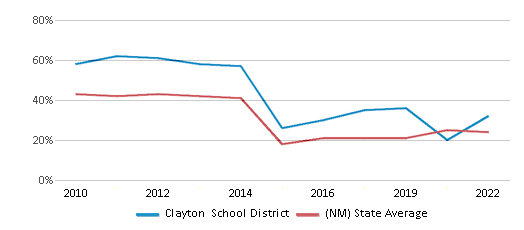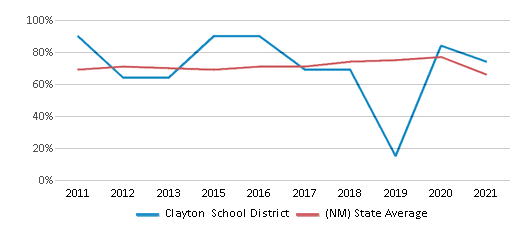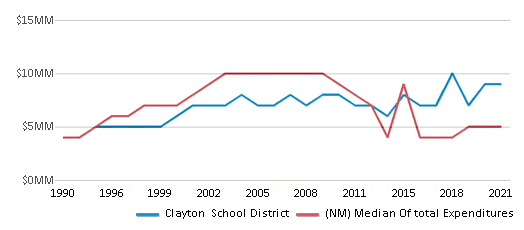For the 2025 school year, there is 1 public high school serving 119 students in Clayton School District. This district's average high testing ranking is 8/10, which is in the top 30% of public high schools in New Mexico.
Public High School in Clayton School District have an average math proficiency score of 30% (versus the New Mexico public high school average of 21%), and reading proficiency score of 50% (versus the 35% statewide average).
Public High School in Clayton School District have a Graduation Rate of 75%, which is more than the New Mexico average of 66%.
The school with highest graduation rate is Clayton High School, with 70-79% graduation rate. Read more about public school graduation rate statistics in New Mexico or national school graduation rate statistics.
Minority enrollment is 69% of the student body (majority Hispanic), which is less than the New Mexico public high school average of 79% (majority Hispanic).
Overview
This School District
This State (NM)
# Schools
3 Schools
264 Schools
# Students
345 Students
120,181 Students
# Teachers
26 Teachers
7,492 Teachers
Student : Teacher Ratio
13:1
13:1
District Rank
Clayton School District, which is ranked within the top 30% of all 143 school districts in New Mexico (based off of combined math and reading proficiency testing data) for the 2021-2022 school year.
The school district's graduation rate of 70-79% has decreased from 90% over five school years.
Overall District Rank
#31 out of 144 school districts
(Top 30%)
(Top 30%)

Math Test Scores (% Proficient)
30-34%
24%

Reading/Language Arts Test Scores (% Proficient)
45-49%
34%

Science Test Scores (% Proficient)
35-39%
33%
Graduation Rate
(20-21)70-79%
66%

Students by Ethnicity:
Diversity Score
0.52
0.57
# American Indian Students
8 Students
14,936 Students
% American Indian Students
2%
12%
# Asian Students
1 Student
1,495 Students
% Asian Students
n/a
1%
# Hispanic Students
206 Students
73,835 Students
% Hispanic Students
60%
62%
# Black Students
5 Students
2,218 Students
% Black Students
2%
2%
# White Students
124 Students
25,039 Students
% White Students
36%
21%
# Hawaiian Students
n/a
176 Students
% Hawaiian Students
n/a
n/a
# Two or more races Students
1 Student
2,482 Students
% of Two or more races Students
n/a
2%
Students by Grade:
# Students in PK Grade:
34
234
# Students in K Grade:
32
951
# Students in 1st Grade:
19
1,023
# Students in 2nd Grade:
28
1,092
# Students in 3rd Grade:
22
1,045
# Students in 4th Grade:
29
1,091
# Students in 5th Grade:
-
1,267
# Students in 6th Grade:
-
2,550
# Students in 7th Grade:
34
3,344
# Students in 8th Grade:
28
3,787
# Students in 9th Grade:
28
29,625
# Students in 10th Grade:
30
27,491
# Students in 11th Grade:
33
24,570
# Students in 12th Grade:
28
22,111
# Ungraded Students:
-
-
District Revenue and Spending
The revenue/student of $22,449 is higher than the state median of $14,756. The school district revenue/student has grown by 17% over four school years.
The school district's spending/student of $24,693 is higher than the state median of $14,121. The school district spending/student has grown by 17% over four school years.
Total Revenue
$8 MM
$4,694 MM

Spending
$9 MM
$4,492 MM

Revenue / Student
$22,449
$14,756

Spending / Student
$24,693
$14,121

Best Clayton School District Public High Schools (2025)
School
(Math and Reading Proficiency)
(Math and Reading Proficiency)
Location
Grades
Students
Rank: #11.
Clayton High School
(Math: 21-39% | Reading: 40-59%)
Rank:
Rank:
8/
Top 30%10
323 South 5th St
Clayton, NM 88415
(575) 374-9611
Clayton, NM 88415
(575) 374-9611
Grades: 9-12
| 119 students
Recent Articles

Year-Round Or Traditional Schedule?
Which is more appropriate for your child? A year-round attendance schedule or traditional schedule? We look at the pros and cons.

Why You Should Encourage Your Child to Join a Sports Team
Participating in team sports has a great many benefits for children, there is no doubt. In this article you will learn what those benefits are.

White Students are Now the Minority in U.S. Public Schools
Increasing birth rates among immigrant families from Asia and Central and South America, combined with lower birth rates among white families, means that for the first time in history, public school students in the United States are majority-minority. This shift in demographics poses difficulties for schools as they work to accommodate children of varying language abilities and socio-economic backgrounds.





